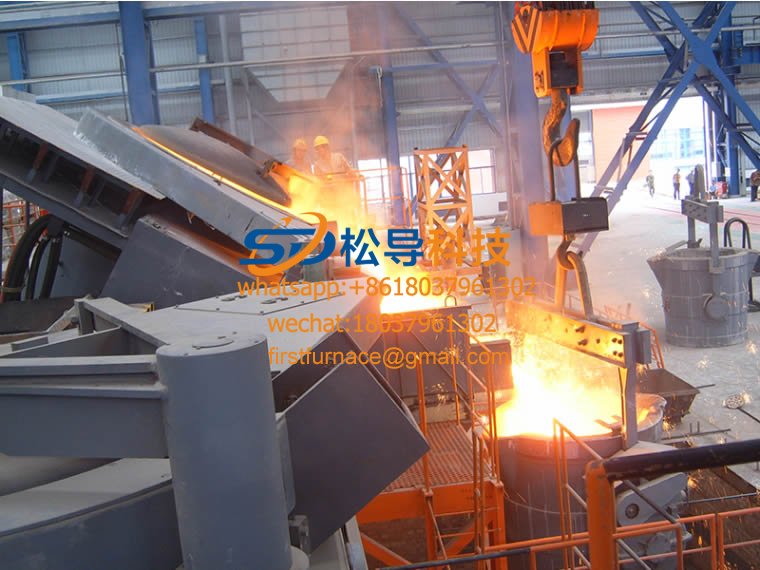


The medium frequency induction furnace refining technology can transform the medium frequency induction furnace from " chemical steel " to steelmaking when smelting alloy steel and special steel, so that its quality index reaches the current AOD, VOD, LF refining furnace, VD vacuum degassing The quality level of the furnace is an important way to improve the quality and reduce waste products for small and medium-sized furnace smelting and casting enterprises. It is a production process with less investment, quick effect, low cost and high quality. It is an energy-saving and consumption-reducing process. The environmentally friendly production process is a process of production. The technology is based on different steel types, different requirements, different gases through the intermediate frequency induction furnace to refine the control gas flow of the gas supply system, to achieve the removal of slag inclusions and 〖 O 〗 〖 N 〗 〖 H 〗 content or special requirements Nitrogen is added to the decarburization and nitrogen-containing steel.
The principle of argon refining in medium frequency induction furnace : Induction furnace bottom argon refining process is completed in pre-deoxidation of molten steel. After sampling and analysis of additional alloying materials, high-purity argon gas is introduced into the molten steel through a gas diffuser installed at the bottom of the furnace ( It will only ventilate without oozing the molten steel. When argon passes through the gas diffuser, the dispersion is higher and the bubble flow has a larger rising speed. Countless bubbles passing through the molten steel will bring 〖 O 〗 〖 N 〗 〖 H 〗 and inclusions out of the molten steel to achieve refining.

Each argon bubble inside the molten steel is a small " vacuum chamber " that does not contain 〖 O 〗 〖 N 〗 〖 H 〗 argon gas bubbles, that is, the partial pressure of these gases in the argon bubble is equal to zero.
When the argon bubble with a high partial pressure passes through the molten steel, the O 〖 N 〗 〖 H 〗 in the dissolved state and the CO in the non-dissolved state will automatically enter the argon bubble and rise as the bubble rises. Spilling, in order to achieve the purpose of degassing, to achieve the purpose of removing non-metallic inclusions.
Since the beginning of August 2011 , the medium frequency induction furnace smelting has been carried out . The purity of the steel after refining has been greatly improved. The contrast of inclusions before and after refining has been significantly reduced, and the gas content has been greatly reduced. The specific comparison is as follows:
1 , the effect of argon refining to remove lead 〖 pb 〗
Steel grade | Blowing Armin | Before refining ( % ) | After refining ( %) | Reduction rate (% ) |
40 | 20 | 0.0087 | 0.0016 | 80.4 |
AISI430 | 19 | 0.0300 | 0.008 | 78.2 |
2 , the effect of argon refining to remove hydrogen 〖 H 〗
Steel grade | Blowing Armin | 〖 H 〗 content Change /10-6 | Reduction rate (% ) | |
Before refining ( % ) | After refining ( %) | |||
40 | 20 | 12.0 | 2.8 | 75.9 |
AISI430 | 35 | 9.3 | 4.51 | 52.1 |
2GMN13 | 31 | 7.9 | 4.15 | 50.0 |
3 , inclusions:
Microscopic evaluation method for non-metallic inclusions in steel GB10561-2005
project | A | B | C | D |
Sulfide | Oxide | Silicate | Spherical oxide | |
Average before refining | Level 1.8 | Level 1.7 | Level 1.5 | Level 2.1 |
Average after refining | Level 0.55 | Level 0.64 | Level 0.5 | 0.67 level |
Average reduction by % | 69 | 62 | 67 | 68 |
The actual measurement standard fully meets the technical requirements:
4 , the hydrogen content is less than 1.0ppm , meet the requirements of mold steel ≦2.5ppm , other steel types ≦3.0ppm .
5 , the nutrient content is less than 0.0050% .
6, after the ingot processing, ultrasonic testing reached (GB / T133515-1991) secondary standard.
7, performance comparison of mechanical refining of stainless steel 304 and stainless steel, etc. :( GB / T328-2002)
1) Tensile strength: refined steel refined in front 549.53Mpa 606.82Mpa improve 57.29Mpa
2) Yield strength: 270Mpa refined steel refined in front 339.52Mpa improve 69.52Mpa
3) maximum force: refined steel after refining before 38.46pa 49.10Mpa improve 10.64Mpa
The technology is applied to induction furnaces and power frequency furnaces. The tonnage is 0.5T-20T furnace body. Practical use
1, the alkaline sand MgO lining. 2 , weakly alkaline MgO + AI 2 O 3 furnace lining. 3 , neutral corundum AI 2 O 3 furnace lining.
4 , acidic neutral AI 2 O 3 + SiO2 furnace lining. 5 , acid quartz sand furnace lining.
This technique does not increase the smelting time, because refining is performed during the melting process of the alloy material, so that the smelting time is not extended, and thus the power consumption is not increased.
Due to the refining of the molten steel, the quality of the product is significantly improved. And the cost has increased. Synchronous increase of 8.23 yuan per ton of steel . The improvement of steel quality, the reduction of waste, and the overall cost are still reduced.
PREV:No More Articles.
NEXT:Smelting Equipment
Copyright© 2007-2013 NO.6 Electric Mall All Rights Reserved
